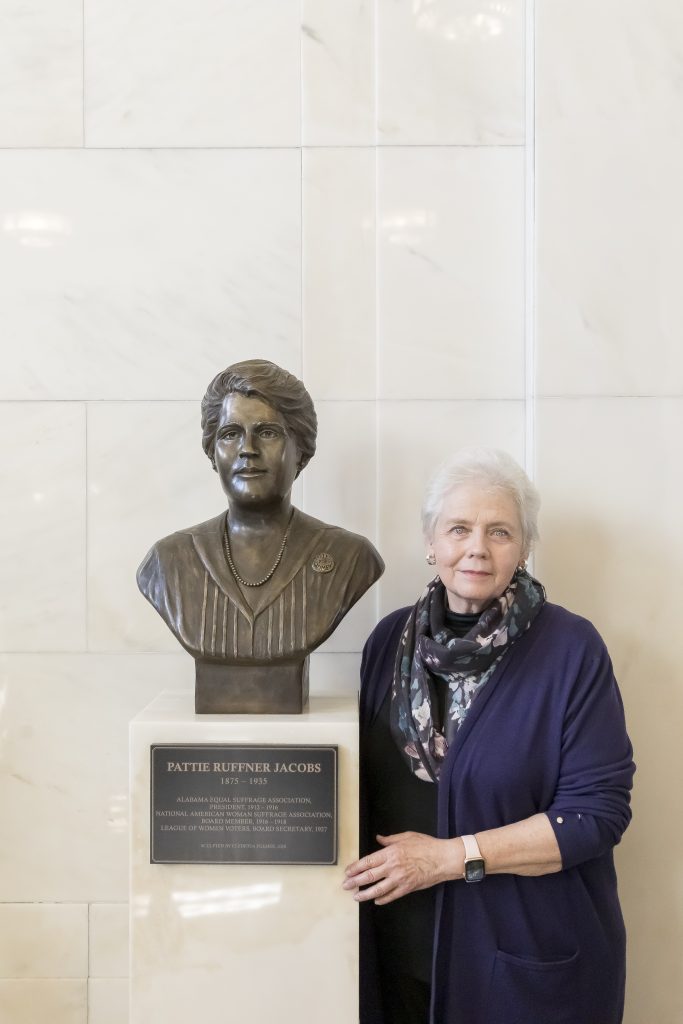
Montgomery native Clydetta Fulmer, a nationally known sculptor, was on hand during the recent unveiling and dedication of her latest works, bronze busts of two Alabama pioneering women — suffragette leader Patty Ruffner Jacobs and civil rights and voting rights activist Amelia Boynton Robinson — at the Alabama Department of Archives and History. She has sculpted more than 100 specially commissioned pieces over the years, with more than 50 in public places, including the life-size statue of Rosa Parks in downtown Montgomery and Helen Keller as a child at the Alabama Public Library Service. Many of her works are on display at Faulkner University, while others are in private collections, including that of singer Amy Grant who commissioned Fulmer to create sculptures of her three children. – Lenore Vickrey
Tell us a little about your background, where you grew up and went to school.
I attended Alabama Christian Academy from the time I entered elementary school through my graduation from high school. My father, Clyde E. Fulmer, was the minister of the Capitol Heights Church of Christ for 33 years. Then he was the associate minister of University Church of Christ for ten years. My mother, Constance R. Fulmer, taught English at Alabama Christian Academy. After I graduated from ACA, I went to Lipscomb University in Nashville, TN. There I received a B.A. with a major in Art.
When did you realize your gifts as an artist, and specifically, as a sculptor? Did you begin creating at an early age?
My family members said that I began drawing soon after I discovered the pencil. My parents and my sisters, Connie and Eunice, thought that I had artistic talent. My mother enrolled me in an art class when I was 9. Besides learning to draw shapes of objects, I learned the basic proportions in drawing the faces of people. When I was about 12, I learned to paint in oils. I learned to paint still life arrangements, flowers, and landscapes. When I was in high school, I began painting portraits. When I was a student at Lipscomb University, I took my first sculpture course. In that class as I was sculpting my first clay portrait sculpture, I thought I had found my medium. I liked the challenge of creating three-dimensional art.
I still occasionally paint or draw a commissioned portrait. I always enjoy those experiences too, and I find the change of medium a refreshing change of pace, but I’m always drawn back to sculpting portrait sculptures in clay for bronze.
I’ve read where you require a year’s lead time to create a life-size sculpture. Tell us a little bit about that process.
I build a framework out of wood attached with metal braces. That framework is called an “armature.” I add clay to the armature and gradually build a clay form and then develop a likeness of my subject. When the clay sculpture has been approved, someone from the foundry comes to my studio and makes a mold of latex and plaster. Wax is poured into the mold. I go to the foundry and inspect the wax and correct any imperfections. The wax is melted out of the shell. That is why it is called the “lost wax” method of bronzing. Then molten bronze is poured into the ceramic shell. The shell is broken away. The bronze sculpture is sandblasted and sprayed with chemicals to achieve the desired finish or patina. Then the sculpture is waxed and delivered.
What has been the most challenging commissioned work you’ve done?
There are so many different kinds of challenges involved with each work. I suppose the most difficult challenge happened in 1991, when my studio was struck by lightning and burned. The studio was declared a total loss. The building’s burning roof collapsed on a full-length life-sized statue I had just finished. I had to rebuild the statue and the studio in the course of that one commissioned work. By the grace of God, I have been blessed with the patience, perseverance, and perspective that I need to gradually move through each difficulty to come to the completion of each of the commissions that I have been given.
When you are not working, how do you like to spend your time?
I like to talk with family members and friends. I enjoy the beauty I see in nature, and I like to make photographs of forests and meadows and lakes and beaches and flowers. I enjoy arranging flowers and caring for plants. I have taught a ladies’ Bible class for many years. Studying the Bible and teaching it is a special joy.




